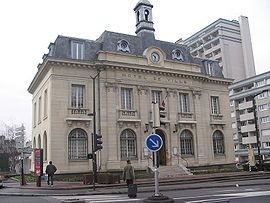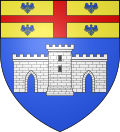Loading AI tools
Commune in Île-de-France, France From Wikipedia, the free encyclopedia
L'Île-Saint-Denis (French: [lil sɛ̃ d(ə)ni] ; lit. 'Saint Denis Island') is a French commune in the northern suburbs of Paris, Île-de-France. It is located 9.4 km (5.8 mi) from the centre of Paris.
You can help expand this article with text translated from the corresponding article in French. Click [show] for important translation instructions.
|
L'Île-Saint-Denis | |
|---|---|
 The town hall of L'Île-Saint-Denis | |
 Paris and inner ring departments | |
| Coordinates: 48°56′00″N 2°20′00″E | |
| Country | France |
| Region | Île-de-France |
| Department | Seine-Saint-Denis |
| Arrondissement | Saint-Denis |
| Canton | Saint-Ouen-sur-Seine |
| Intercommunality | Grand Paris |
| Government | |
| • Mayor (2020–2026) | Mohamed Gnabaly[1] |
| Area 1 | 1.77 km2 (0.68 sq mi) |
| Population (2021)[2] | 8,664 |
| • Density | 4,900/km2 (13,000/sq mi) |
| Demonym | Îlodionysiens |
| Time zone | UTC+01:00 (CET) |
| • Summer (DST) | UTC+02:00 (CEST) |
| INSEE/Postal code | 93039 /93450 |
| Website | www.lile-saint-denis.fr |
| 1 French Land Register data, which excludes lakes, ponds, glaciers > 1 km2 (0.386 sq mi or 247 acres) and river estuaries. | |
The commune is entirely contained on an island of the Seine, hence its name.
Along with the communes of Saint-Denis and Saint-Ouen-sur-Seine, L'Île-Saint-Denis will form the Olympic Village of the 2024 Summer Olympics.[3] This allows 85% of athletes to be 30 minutes from their competition venues.
 |
The arms of l'Île-Saint-Denis are blazoned : Azure, a castle argent pierced and masoned sable extended by walls argent masoned sable, open of the field, and on a chief Or, a cross gules between 4 alerions azure.
|
Several transit connections are located nearby. The closest station to l'Île-Saint-Denis is Saint-Denis station, which is an interchange station on Paris RER line D and on the Transilien Paris – Nord suburban rail line. This station is located in the neighboring commune of Saint-Denis, 0.4 km (0.25 mi) from the town center of l'Île-Saint-Denis.
Tram T1 stops near Île-Saint-Denis's town hall. Bus route 237 runs along the length of the island.
The island is the result of the joining of several smaller islands (which helps explain its current length): L’île Saint-Denis, l’île Saint-Ouen, l’île des Vannes[4] and l'île du Châtelier.
Since the 1960s l'Île-Saint-Denis has housed immigrants, mostly from North African countries. Nadir Dendoune, a local author, said that l'Île-Saint-Denis had racial and ethnic diversity in the 1980s, as the neighborhood housed various groups of poor people, including Arabs, Black people, ethnic French, and other Europeans, and that at that time half of the students in area schools were White. In 2005, according to Dendoune, few of the students were White.[5]
| Year | Pop. | ±% p.a. |
|---|---|---|
| 1968 | 5,522 | — |
| 1975 | 7,004 | +3.45% |
| 1982 | 7,435 | +0.86% |
| 1990 | 7,413 | −0.04% |
| 1999 | 6,810 | −0.94% |
| 2007 | 7,083 | +0.49% |
| 2012 | 6,981 | −0.29% |
| 2017 | 7,981 | +2.71% |
| Source: INSEE[6] | ||
There are three primary schools in the commune: École Samira Bellil, École Paul Langevin, and École Jean Lurçat.[7]
Collège Alfred Sisley, a junior high school, is on the island.[8]
Seamless Wikipedia browsing. On steroids.
Every time you click a link to Wikipedia, Wiktionary or Wikiquote in your browser's search results, it will show the modern Wikiwand interface.
Wikiwand extension is a five stars, simple, with minimum permission required to keep your browsing private, safe and transparent.